
 |
Citaat:
Maar lang niet zo hypothetisch als jouw holle aarde fantasie (een hypothese wil ik het niet eens noemen, daarvoor zit er te weinig vlees aan). Het graviton past in de huidige theorien, het is een deel van een verklarend geheel dat resultaten oplevert. Jouw fantasie komt niet tot aan de teennagel van dergelijke theorie, er is niets dat het verklaard, niets dat het ondersteunt, niets dat het verduidelijkt. Gewoon het zoveelste zotte idee van arrogante nitwits. |
Citaat:
Maar dit is enkel omdat jullie zo zwak zijn. In het 9/11 topic is dit zeer duidelijk. Tov van mieren ben jij geniaal , toegegeven. |
Citaat:
Wel een barslechte vergelijking hé Het eerste is waar te nemen, te herhalen en zelfs te isoleren tot laboniveau Het tweede is helemaal niet waargenomen ... laat staan de rest Citaat:
Uiteraard zouden we dat wel graag hebben... ondertussen is die al aardig op weg Om nog maar eens over Le Sage te beginnen : Dat was een poging, een zeer goede en verdienstelijke zelf om het boeltje te verklaren, maar helaas... Als ze niet overeenkomt met de werkelijkheid moet ge het laten varen en opnieuw beginnen |
Citaat:
Zijn theorie komt net wel overeen met de werkelijkheid: we worden gebombardeerd met deeltjes uit het heelal! |
Citaat:
|
Och ja. Weet je wat het probleem is? Ik praat hier met ouwe peten.
Rustige vastheid jonges.. Scheve bomen kun je niet meer rechttrekken Weet je? Ik ben niet gebrainwashed geweest. Dat is het verschil. Ik denk met logisch verstand. Ook al ken ik de huidige theorieën, ik ben het niet mijn strot ingeduwd geweest. Ik leer mijn zoon de holle aarde theorie. Wedden dat hij later de verschuiving van continenten door een lavastroompje onzin vindt? De groeiende Aarde is een 1000x logischere verklaring voor de continentenstand op de dag van vandaag. Een neutraal persoon kan dit niet ontkennen. Enkel uitzetting is nodig. Dat het mechanisme nog niet duidelijk is, dat kan best wel zijn. Het is dan ook een mysterie. Voorlopig. Als we weten hoe het juist zit is het een feit. |
Citaat:
|
Zeg ne keer, als zwaartekracht is zoals we het kennen, waarom zit de massa niet in het centerpunt?
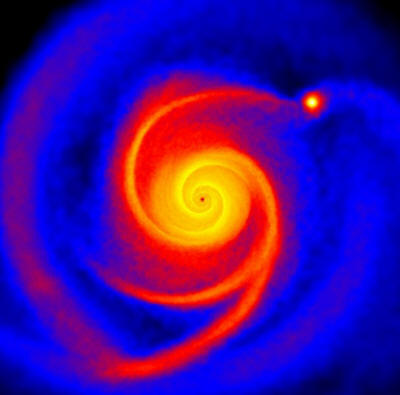 Zie je de vortex? = MECHANISME |
Waarom zijn de polen zo warm?
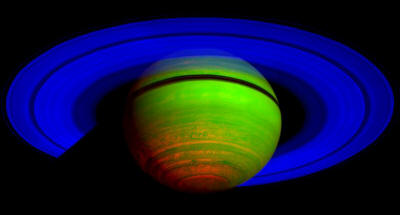 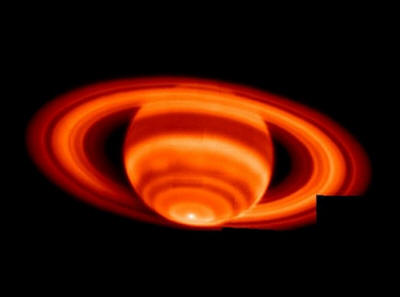 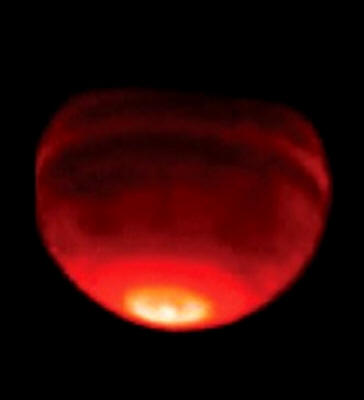 Omdat er gaten in de polen zitten en de inwendige zon voor de opwarming van de binnenkant zorgt |
Citaat:
En als die post boven deze klopt dan moet het op de aardse Polen dus ook extra warm zijn. Nee, neem de tijd... |
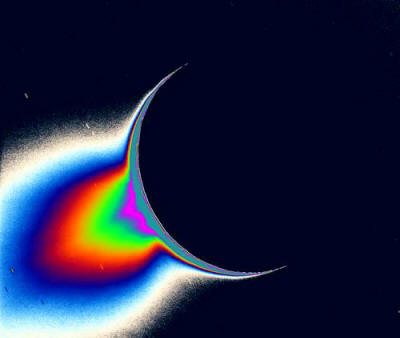 On a close approach, Cassini found that the southern polar plume from geysers at Enceladus' south pole contain 20 times more organic material than was previously expected Scientists remark, "To have primordial material coming out from inside a Saturn moon raises many questions on the formation of the Saturn system." I would say this is a bit of an understatement. In fact, Enceladus is just one more example of how little we understand about planetary dynamics and geophysics. Our fundamental assumptions of the mechanics of planetary formation, construction, and internal energetic dynamos is crying out for a much-needed overhaul. The simple fact that we see energetic fountains or hot spots at the poles of planetary bodies as small as Enceladus or Titan, begs for a further assessment of how we view the evolution or the formation of the solar system, not just the Saturn system. |
|
Citaat:
|
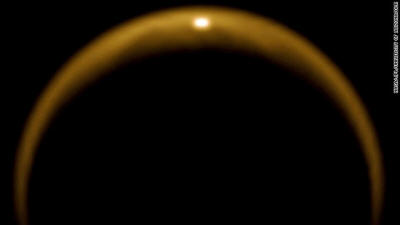  The visual and infrared mapping spectrometer instrument onboard Cassini has found an unusual bright, red spot on Titan. This dramatic color (but not true color) image was taken during the April 16, 2005, encounter with Titan. North is to the right. In the center it shows the dark lanes of the "H"-shaped feature (see http://www.nasa.gov/mission_pages/ca.../pia06407.html) discovered from Earth and first seen by Cassini last July shortly after it arrived in the Saturn system. At the southwestern edge of the "H" feature, near Titan's limb (edge), is an area roughly 500 kilometers (300 miles) across. That area is 50 percent brighter, when viewed using light with a wavelength of 5 microns, than the bright continent-sized area known as Xanadu (see http://www.nasa.gov/mission_pages/ca.../pia06107.html). Xanadu extends to the northwest of the bright spot, beyond the limb (edge) of Titan in this image. Near the terminator (the line between day and night) at the bottom of this image is the 80 kilometer (50 mile) crater that has been previously seen by the Cassini radar, imaging cameras, and the visual and infrared spectrometer (see http://www.nasa.gov/mission_pages/ca.../pia07868.html). At wavelengths shorter than 5 microns, the spot is not unusually bright. The strange spectral character of this enigmatic feature has left the team with four possibilities for its source: the spot could be a surface coloration, a mountain range, a cloud, or a hot spot. |
Citaat:
Hier ook: (met wolken) https://www.youtube.com/watch?v=P6g_l-cCoGg |
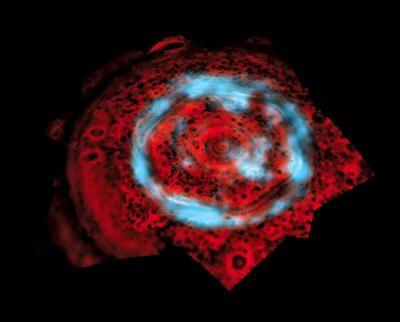 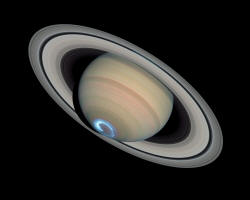 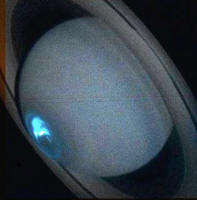 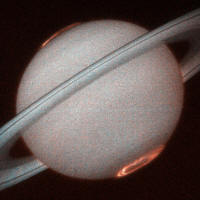 De aurora's van Saturnus zijn NIET veroorzaakt door de Zon!! |
https://news.agu.org/press-release/e...n-interaction/
 In the aurora-making interaction of Jupiter and Io, volcanoes on the small moon blast clouds of electrically charged atoms (ions) and electrons into a region surrounding Jupiter that’s permeated by the planet’s powerful magnetic field, thousands of times stronger than Earth’s. Rotating along with its rapidly spinning planet, the magnetic field drags the material from Io around with it, causing strong electric fields at Jupiter’s poles. The acceleration of the ions and electrons produce intense auroras that shine in almost all parts of the electromagnetic spectrum but most brightly in high-energy bands, like ultraviolet light and X-rays, that are invisible to unaided human eyes. Now, new observations of the planet’s extreme ultraviolet emissions show that bright explosions of Jupiter’s aurora likely also get kicked off by the planet-moon interaction, not by solar activity. A new scientific paper about these observations by Tomoki Kimura of the Japan Aerospace Exploration Agency (JAXA), in Sagamihara, Kanagawa, Japan, and his colleagues, was published online today in Geophysical Research Letters, a journal of the American Geophysical Union. Starting in January 2014, a telescope aboard the JAXA’s Hisaki satellite, which focused on Jupiter for two months, recorded intermittent brightening of the giant planet’s aurora. The telescope detected sudden flare-ups on days when the usual flow of charged particles from the Sun, known as the solar wind, was relatively weak. Additional space and ground-based telescopes, including the Hubble Space Telescope, also viewed Jupiter during these lulls in the solar wind. Both Hisaki and Hubble witnessed explosions of the planet’s aurora despite the solar wind’s calm, suggesting that it’s the Jupiter-Io interaction driving these explosions, not charged particles from the Sun, according to the new study. The new research does not address exactly what is happening in the Jovian magnetosphere to cause the temporary brightening of auroral explosions. BTW laat die moon planeet interactie maar achterwege :) Dat is bullshit. Is om toch een uitleg te kunnen geven. Zijn onze aurora's dan ook wisselwerking tussen maan-aarde? |
 Since the late 1950s and '60s, scientists have believed that the Earth's magnetic field has captured a lot of the solar wind - charged particles flowing out from the sun - and formed an immense, comet-like cloud of electrified gas that surrounds our planet. An accidental discovery in the 1980s and new data collected since 1996 indicate that this magnetosphere may well be filled by a fountain of energized gas (right) blowing from the north and south poles. You don't need to stock up on bottled air - the leakage is tiny compared to Earth's atmosphere - but the studies are making us take a new look at 40-year-old assumptions about how the Earth interacts with the space environment. The new look will be discussed in two papers by Drs. Rick Chappell and Barbara Giles at the fall meeting of the American Geophysical Union in San Francisco. Chappell and Giles are plasma physicists at NASA's Marshall Space Flight Center. Starting with the discovery of the Van Allen radiation belts by the first U.S. satellite in 1958, scientists have known that the Earth is surrounded by a cloud of electrified gas. This cloud, called the magnetosphere, is constrained by Earth's magnetic field, compressed by the solar wind to within about 100,000 km of the Earth on the sunward side, and drawn out by the solar wind to more than a million km on the night side. "The conventional wisdom from the time I was in school 30 years ago," said Chappell, NASA/Marshall's associate director for science, "was that because these ions have so much energy (about 1,000 electron-volts [1 keV], they must come from the sun." "Why should it be from the ionosphere?" Giles asked, repeating the thinking of the 1960s and '70s. The ionosphere, the top layer of Earth's atmosphere from about 60 km and up, is composed of ionized atoms and molecules. "It's so cold. What they were measuring they assumed came from the solar wind because the energies were right." The perception started to change in the mid-1980s following the Aug. 3, 1981, launch of two Dynamics Explorer satellites designed to study the magnetosphere near the Earth. DE-1 carried Chappell's Retarding Ion Mass Spectrometer (RIMS), designed to measure the population of the plasmasphere, a torus or donut of low-energy in the inner magnetosphere. To Chappell's surprise, the real find was around the north pole where RIMS measured gases flowing upward from the ionosphere into space as DE-1 arced to about 4.6 Earth radii above the pole (the orbit was 464 x 23,370 km [288 x 14,490 mi]). "The more we measured it," he said, "the more we realized that this was a big source of material." RIMS measured ions of hydrogen, helium, oxygen, and nitrogen rising at different speeds and on different trajectories. Apparently, the particles that slammed into the ionosphere to paint the aurora borealis also energized enough atoms to head spaceward. (The same is true of the south pole where DE-1 made similar observations.) The acceleration mechanism is not fully understood, though. Giles said that very low frequency (VLF) radio waves, emitted in the magnetosphere, may contribute energy. In 1987, Chappell and the RIMS team published a paper describing the polar ion fountain and described the ionosphere as a "fully adequate source of material for the magnetosphere." That means that scientists did not need to look to the solar wind to fill the magnetosphere. Earth, they contended, does a good job of supplying all the materials. Hé, VREEMD niet? Maar ja, ik ben wacko om te denken wat ik beweer hé.. |
Citaat:
Het is een computer simulatie van een observatie van een geboorte van een planeet |
Dit is ook een observatie van de geboorte van een planeet:
 http://www.webpronews.com/giant-plan...ations-2013-01 Zie je de 2 vortices???? STER/KERN IN HET MIDDELPUNT! |
| Alle tijden zijn GMT +1. Het is nu 04:41. |
Forumsoftware: vBulletin®
Copyright ©2000 - 2025, Jelsoft Enterprises Ltd.
Content copyright ©2002 - 2020, Politics.be